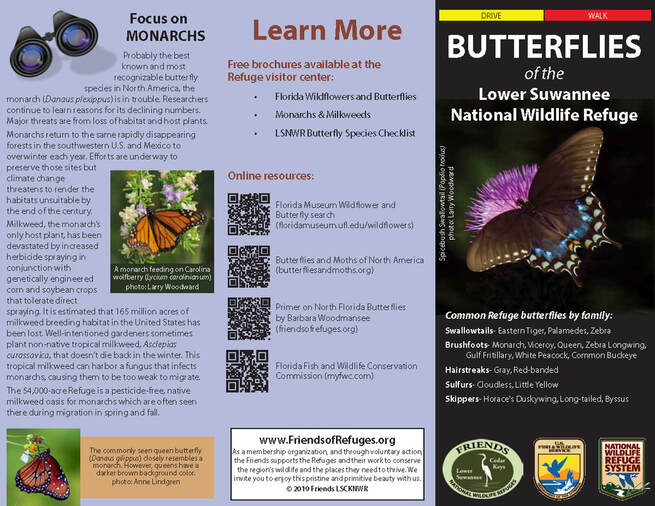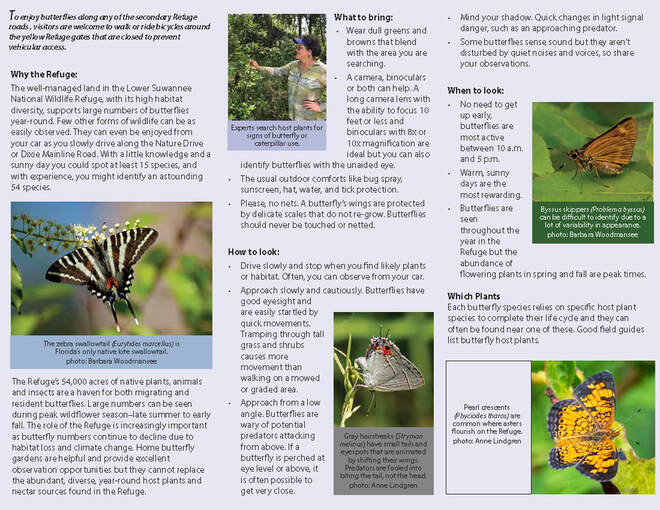Identify butterflies using Barbara Woodmansee's guide.
Focus on MONARCHS
Probably the best known and most recognizable butterfly species in North America, the monarch (Danaus plexippus) is in trouble. Researchers continue to learn reasons for its declining numbers. Major threats are from loss of habitat and host plants. Monarchs return to the same rapidly disappearing forests in the southwestern U.S. and Mexico to overwinter each year. Efforts are underway to preserve those sites but climate change threatens to render the habitats unsuitable by the end of the century. Milkweed, the monarch’s
only host plant, has been devastated by increased herbicide spraying in conjunction with genetically engineered corn and soybean crops that tolerate direct spraying. It is estimated that 165 million acres of milkweed breeding habitat in the United States has been lost. Well-intentioned gardeners sometimes plant non-native tropical milkweed, Asclepias curassavica, that doesn’t die back in the winter. This tropical milkweed can harbor a fungus that infects monarchs, causing them to be too weak to migrate. The 54,000-acre Refuge is a pesticide-free, native milkweed oasis for monarchs which are often seen there during migration in spring and fall.
Probably the best known and most recognizable butterfly species in North America, the monarch (Danaus plexippus) is in trouble. Researchers continue to learn reasons for its declining numbers. Major threats are from loss of habitat and host plants. Monarchs return to the same rapidly disappearing forests in the southwestern U.S. and Mexico to overwinter each year. Efforts are underway to preserve those sites but climate change threatens to render the habitats unsuitable by the end of the century. Milkweed, the monarch’s
only host plant, has been devastated by increased herbicide spraying in conjunction with genetically engineered corn and soybean crops that tolerate direct spraying. It is estimated that 165 million acres of milkweed breeding habitat in the United States has been lost. Well-intentioned gardeners sometimes plant non-native tropical milkweed, Asclepias curassavica, that doesn’t die back in the winter. This tropical milkweed can harbor a fungus that infects monarchs, causing them to be too weak to migrate. The 54,000-acre Refuge is a pesticide-free, native milkweed oasis for monarchs which are often seen there during migration in spring and fall.
Why the Refuge:
The well-managed land in the Lower Suwannee National Wildlife Refuge, with its high habitat diversity, supports large numbers of butterflies year-round. Few other forms of wildlife can be as easily observed. They can even be enjoyed from your car as you slowly drive along the Nature Drive or Dixie Mainline Road. With a little knowledge and a sunny day you could spot at least 15 species, and with experience, you might identify an astounding 54 species.
The Refuge’s 54,000 acres of native plants, animals and insects are a haven for both migrating and resident butterflies. Large numbers can be seen during peak wild flower season–late summer to early fall. The role of the Refuge is increasingly important as butterfly numbers continue to decline due to habitat loss and climate change. Home butterfly gardens are helpful and provide excellent observation opportunities but they cannot replace the abundant, diverse, year-round host plants and nectar sources found in the Refuge.
What to bring:
• Wear dull greens and browns that blend with the area you are searching.
• A camera, binoculars or both can help. A long camera lens with the ability to focus 10 feet or less and binoculars with 8x or 10x magnification are ideal but you can also identify butterflies with the unaided eye.
• The usual outdoor comforts like bug spray, sunscreen, hat, water, and tick protection.
• Please, no nets. A butterfly’s wings are protected by delicate scales that do not re-grow. Butterflies should never be touched or netted.
How to look:
• Drive slowly and stop when you find likely plants or habitat. Often, you can observe from your car.
• Approach slowly and cautiously. Butterflies have good eyesight and are easily startled by quick movements.
Tramping through tall grass and shrubs causes more movement than walking on a mowed or graded area.
• Approach from a low angle. Butterflies are wary of potential predators attacking from above. If a butterfly is perched at eye level or above, it is often possible to get very close.
• Mind your shadow. Quick changes in light signal danger, such as an approaching predator.
• Some butterflies sense sound but they aren’t disturbed by quiet noises and voices, so share your observations.
When to look:
• No need to get up early, butterflies are most active between 10 a.m. and 5 p.m.
• Warm, sunny days are the most rewarding.
• Butterflies are seen throughout the year in the Refuge but the abundance of flowering plants in spring and fall are peak times.
Which Plants
Each butterfly species relies on specific host plant species to complete their life cycle and they can often be found near one of these. Good field guides list butterfly host plants. Check out our butterfly field guide which lists 90 species documented on the Lower Suwannee Refuge by Barbara Woodmansee.
The well-managed land in the Lower Suwannee National Wildlife Refuge, with its high habitat diversity, supports large numbers of butterflies year-round. Few other forms of wildlife can be as easily observed. They can even be enjoyed from your car as you slowly drive along the Nature Drive or Dixie Mainline Road. With a little knowledge and a sunny day you could spot at least 15 species, and with experience, you might identify an astounding 54 species.
The Refuge’s 54,000 acres of native plants, animals and insects are a haven for both migrating and resident butterflies. Large numbers can be seen during peak wild flower season–late summer to early fall. The role of the Refuge is increasingly important as butterfly numbers continue to decline due to habitat loss and climate change. Home butterfly gardens are helpful and provide excellent observation opportunities but they cannot replace the abundant, diverse, year-round host plants and nectar sources found in the Refuge.
What to bring:
• Wear dull greens and browns that blend with the area you are searching.
• A camera, binoculars or both can help. A long camera lens with the ability to focus 10 feet or less and binoculars with 8x or 10x magnification are ideal but you can also identify butterflies with the unaided eye.
• The usual outdoor comforts like bug spray, sunscreen, hat, water, and tick protection.
• Please, no nets. A butterfly’s wings are protected by delicate scales that do not re-grow. Butterflies should never be touched or netted.
How to look:
• Drive slowly and stop when you find likely plants or habitat. Often, you can observe from your car.
• Approach slowly and cautiously. Butterflies have good eyesight and are easily startled by quick movements.
Tramping through tall grass and shrubs causes more movement than walking on a mowed or graded area.
• Approach from a low angle. Butterflies are wary of potential predators attacking from above. If a butterfly is perched at eye level or above, it is often possible to get very close.
• Mind your shadow. Quick changes in light signal danger, such as an approaching predator.
• Some butterflies sense sound but they aren’t disturbed by quiet noises and voices, so share your observations.
When to look:
• No need to get up early, butterflies are most active between 10 a.m. and 5 p.m.
• Warm, sunny days are the most rewarding.
• Butterflies are seen throughout the year in the Refuge but the abundance of flowering plants in spring and fall are peak times.
Which Plants
Each butterfly species relies on specific host plant species to complete their life cycle and they can often be found near one of these. Good field guides list butterfly host plants. Check out our butterfly field guide which lists 90 species documented on the Lower Suwannee Refuge by Barbara Woodmansee.

Friends of the Lower Suwannee & Cedar Keys National Wildlife Refuges
P. O. Box 532 Cedar Key, FL 32625 [email protected] We are a 501(c)(3) nonprofit organization. |
|

